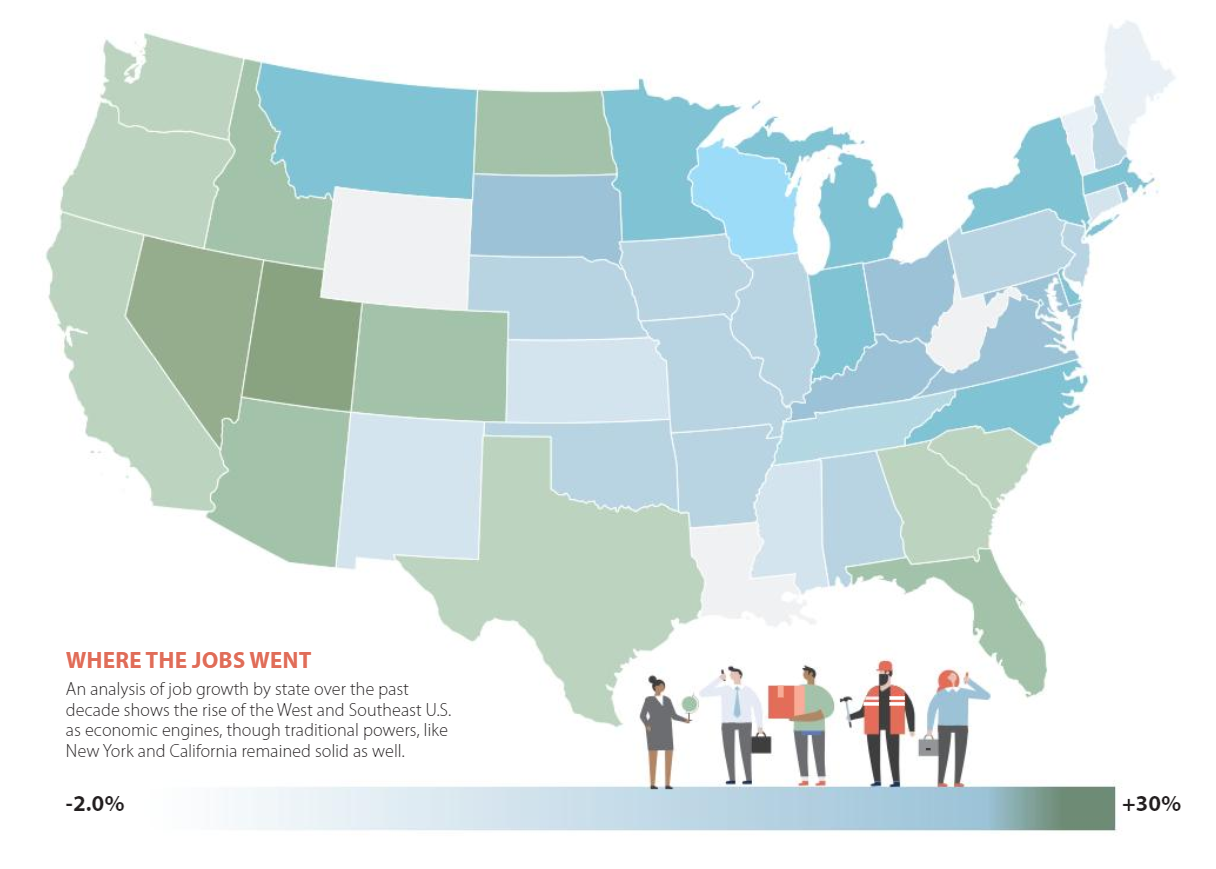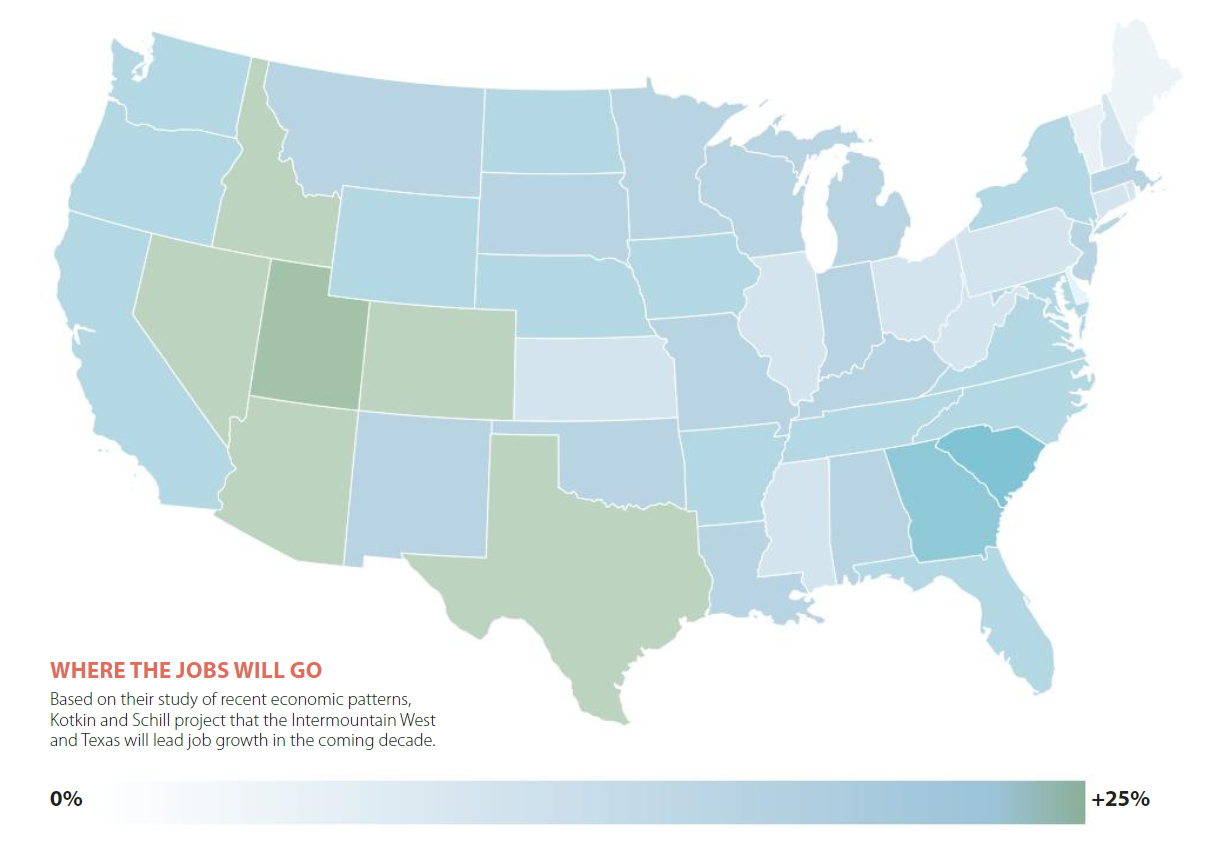How is Iowa Emerging in ‘The Next Economy'?
posted on Monday, March 9, 2020 in Economic Development
 Written by Aaron Jarnagin, Digital Marketing Specialist
Written by Aaron Jarnagin, Digital Marketing Specialist
Where is the economy headed in the next decade? Will the southwestern edge of the country see the same wild increase in jobs as it saw in the last decade, or is the tide changing?
By extension, how is the Cedar Valley positioned for growth? This article is a means to highlight overall job growth trends and how the "geeks" are going to be taking over.
Kotkin and Schill, two of America’s most influential regional analysts, are not thinking the coastal job creation extravaganza will continue; in fact, they propose quite the opposite as the job creation trend shifts inland.
An industry publication that Grow Cedar Valley follows is the CEO Guide to Site Selection released by the Chief Executive. In the publication, Kotkin and Shill were asked to “follow the trail of U.S. job growth and opportunity over the past decade—and hunt for clues about the next decade.”

Above is a graphic from the 'Chief Executive' on where jobs went over the last decade.
This publication, released annually, analyses economic indicators, comparing states side by side; taking a look at population growth, state incentives and sharing c-suite testimonials about each state.
Last year, the guide highlighted the labor market and the changes companies will need to make to stay relevant to a changing labor force. They compared the “The Older Guard” and the positions that currently make up the workforce to “Where the Geeks Go”, highlighting professional, scientific & technical services, information, and finance & insurance are going to be the hottest job growth industries across the country.

Above is a graphic from 'Chief Executive' on where jobs will go over the next decade.
So, with these industries leading the charge toward “The Next Economy”, how does Iowa fare?
Iowa is in the middle of the pack but positioned for growth.
While most of the key growth will be in the Sunbelt and Internmountian Western region of the United States (marked green), growth will not be as centralized as it has been. We are seeing a leveling out of the competition.
Why?
Kotkin and Schill say to “follow the taxes” and the cost of living. Many of the states that have traditionally done well (California for example) are no longer viable due to increased living costs and high regulation. These two labels spell high costs for new businesses looking to enter these markets, which suggests the reasoning for the growth elsewhere. We are seeing evidence of this elsewhere as well.
The Waterloo-Cedar Falls Courier reported on an article on Iowa’s competitive dashboard developed by the Iowa Business Council (IBC). “The IBC, whose members employ about 163,000 Iowans, was formed in 1985 during that decade’s farm crisis to shore up the state’s economy during the downturn, council director Joe Murphy said. It has compiled figures for the “competitive dashboard” since 2011.”
“While Iowa’s population growth trails the nation, the rate of “out-migration” of young people leaving the state for employment has declined by nearly 30%,” shared by Murphy. Additionally, while Iowa's corporate tax "sticker price" remains high compared to many other states, the incentives offered to offset those costs allow Iowa to remain competitive.
Lower cost of living and the opportunities that can provide has real effects on people and businesses. Cost of living tools and resources must be available to help position Iowa as an opportunity for those discontent with their current community.
So, how does Iowa compete in “The Next Economy” and position ourselves with industries that will fuel growth?
Iowa currently sits in a crucial position to determine how this next decade goes. In tech and professional occupations, Iowa sits as an emerging market with high growth of jobs but a low overall volume of positions. However, Iowa remains a star in production and manufacturing, offering high job growth with a high volume of positions. Production will remain a key driver for communities and jobs as the march to Industry 4.0 continues.
Additionally, awareness is key. The Cedar Valley launched a movement to promote the opportunities that are available in our communities. Our message needs to break through the noise and resonate with those who have the skills key to success in this decade.
The Chief Executive publication does a great job of sharing the outlook for the next decade and I highly recommend you take some time to review it.